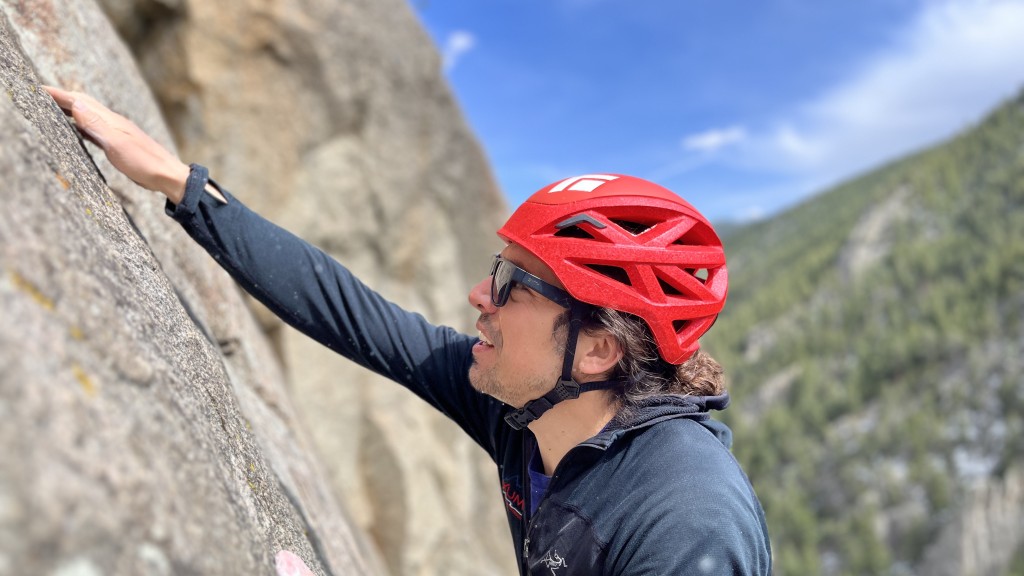14 Best Climbing Helmets of 2024
Best Climbing Helmets: A climbing helmet is an essential piece of outdoor climbing gear, whether you’re backpacking or rock climbing. Climbing helmets protect the head from falling rocks and side impacts (such as impacts to the head from falling balls) and prioritize comfort and stylish design. The best climbing helmet is the one that fits your head, but your decision will depend on appearance, materials and weight. Below we look at the best climbing helmets of 2024, from lightweight models to more affordable options. For more information, see the headphone comparison table and detailed buying advice below the selection.
Best all-round climbing helmets
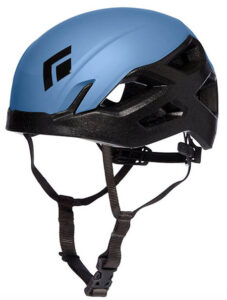
1.Black Diamond Vision
Weight: 7.5 ounces. (small/medium size)
Construction: EPP and EPS with ABS shell
What we like: Lightweight, durable, attractive and all at an affordable price.
What we don’t do: It doesn’t stand out in any way.
If you travel to all the climbing spots in the United States, the helmet you see is unlikely to be the one you see the most. This award could go to Petzl Sirocco or Black Diamond Half Dome, both with beautiful covers. But while the sleek Sirocco is a bit overkill for rocks and the Budget Half Dome is heavy (and won’t earn any points for style), the Vision does it all with a lightweight 7.5 ounces and an ABS frame attractive and durable. The shell is essentially an EPP foam construction (quick disclaimer: EPP is more expensive than EPS, but it absorbs impacts rather than collapsing – more on that in our buying tips below). And at just $100, it’s a great price.
But while vision is better in all areas, it is not superior in any parameter. The Vapor and Petzl Sirocco are 2 ounces lighter and significantly more aerodynamic, making them a better choice for long rides, trying to get past the red dot, or for light, fast work. And if durability is your top priority, there’s no helmet like the Petzl Boreo or BD Capitan, both of which feature a full-shell ABS shell and similar EPP/EPS foam construction. But for those looking for a lightweight, durable, attractive and relatively affordable off-road helmet, the Vision is the Goldilocks helmet that does it all. Black Diamond also offers a MIPS version ($150) that improves corner impact protection.
Best budget climbing helmet

2. Petzl Borio ($60)
Weight: 10.1 oz. (small/medium size)
Construction: EPP and EPS with ABS shell.
What we like: A very durable basic helmet available in men’s and women’s sizes.
What we don’t do: Less adjustments compared to Half Dome.
Since protection is a given (all helmets here meet the same safety certification), new mountaineers’ main priority when purchasing a helmet should be: price. Here’s the good news: Boreo headphones are not only the most affordable at $60, but they’re also one of the most durable. Made with an ABS shell and incorporating expanded polystyrene and expanded polypropylene, you get maximum impact protection from the top and sides. In other words, the Boreo’s construction uses the strongest shell material and strongest foam, making it one of the most durable helmets on the market. You can throw this thing away, put it in the bottom of your backpack, use and abuse it for years and it will still work.
Not only is the Boreo one of the most durable and affordable climbing helmets, but it is also relatively lightweight for an entry-level model (1.5 ounces lighter than the Half Dome featured below). In addition, you will benefit from generous ventilation in hot weather and a suspension system that adapts well to the crown of the helmet. We think Petzl could improve the suspension system, as the two-handed adjusters and fixed under-ear straps aren’t as easy to use as the Half Dome’s control wheel and adjustable straps. But the benefits far outweigh these minor inconveniences, and Boreo (and Boreo for women) is the best option for shoppers on a budget. In second place is the new Black Diamond Capitan, which matches the Petzl in durability and adds a little more style for just $10.
best ultralight climbing helmet
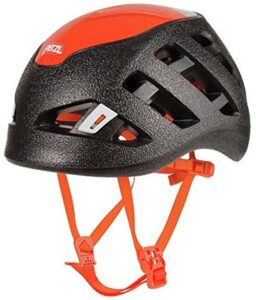
3. Petzel Scirocco
Weight: 5.6 oz. (small/medium size)
Construction: EPP and EPS with polycarbonate shell.
What we like: Lightweight, comfortable and breathable.
What we don’t do: The magnetic chin strap can become clogged with dirt.
The original Petzl Sirocco revolutionized the climbing world with its lightweight, durable design and quickly won the support of many serious climbers. The second version is based on the first, with similar foundations but a more traditional look. Like the previous Black Diamond Vision, the Sirocco uses a blend of expanded polypropylene (EPP) and expanded polystyrene (EPS), but thanks to its polycarbonate lower body and slimmer design, it weighs about 2 ounces less. In fact, this helmet is so light that you’ll forget it’s on your head.
The Sirocco is the ideal helmet for climbers counting ounces, and its somewhat aerodynamic shape fits well even in a small backpack. It’s also certified for ski touring, which puts it in an exclusive category alongside the Petzl Meteor below. It should be noted that we weren’t very impressed with Petzl’s magnetic chin strap and back strap, which tend to loosen or loosen when climbing. But the Sirocco’s lightweight design and compact size make it our favorite choice for everything from mountain traverses to challenging climbs in Patagonia, and the suspension offers a much better fit than the wobbly vapor underneath.
best of the rest
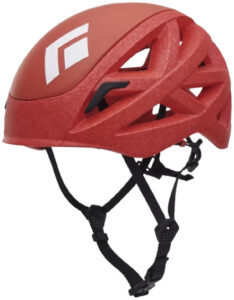
4. Black diamond steam
Weight: 5.5 oz. (Evening)
Construction: EPP and EPS with polycarbonate shell.
What we like: The chin guard is more confidence-inspiring than the Sirocco.
What we don’t: More expensive than Scirocco; A good fit is difficult to achieve.
Black Diamond’s Vapor helmet has been a top-of-the-line helmet for years, praised for its light weight, excellent ventilation and better looks. Historically, however, it hasn’t been the most durable hat (we’ve broken (and thrown away) a few Vapor models over the past decade, making its high price difficult to stomach. This year, however, the Classic Helmet gets a higher price tag. facelift. The new Vapor is now lightweight: weighing an incredible 5.5 ounces, it is extremely durable and as attractive as ever.
Both Vapor and Sirocco use a combination of EPP and EPS foam with a polycarbonate shell; The only way to make it more durable with modern technology is to use a stronger (and heavier) ABS casing like the Boreo above or the Capitan below. Additionally, the weight of the two headphones is nearly identical: on our scale, the Black Diamond weighs just 1 gram less (or 0.04 ounces). The main difference is the adjustment: the two suspension systems are very simplified, but the Vapor system is more complex and difficult to adjust; Our helmet is almost always on our head (although we definitely appreciate the BD’s safer chin). bump up). Both are lightweight, high-quality models from two of the best manufacturers in the business, but we give the edge to the Petzl for its lower price, better fit, and ski touring certification.
5. Petzel Meteorite
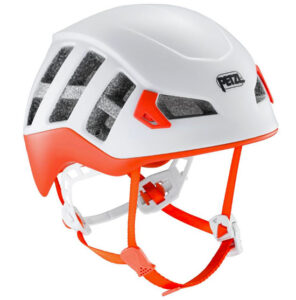
Weight: 7.9 oz. (small/medium size)
Construction: EPS with polycarbonate shell.
What we like: Four-season mountaineering helmet at a great price; The fit is comfortable and easily adjustable.
What we don’t know: EPS foam is more fragile than EPP Sirocco.
Petzl’s Meteor is a real sight to behold and one of our favorite helmets of 2024. Notably, this is the first CE-certified ski helmet (Sirocco soon joined this category) with a shape that fits ski goggles skis, including a rear binding and a high-quality adjustment system. Expands to fit under a hat. The Meteor also features ample neck coverage and excellent breathability. Overall, this high-quality cover is a complete package for four-season mountain riders and is very reasonably priced at just $90.
With its ski touring versatility, excellent coverage and competitive price, the Meteor is our favorite polycarbonate shell EPS canopy. But there are some downsides to this design, namely that EPS foam is less durable and less protective than the more modern polyethylene foam used in helmets like the aforementioned Petzl Sirocco and Black Diamond Vapor. Therefore, you need to handle the meteorite carefully to prolong its life. But the Petzl is still excellent value for money, and its suspension system is much easier to adjust than the Sirocco or Vapor (including the rear ratchet and under-ear adjusters).
6. Captain Black Diamond
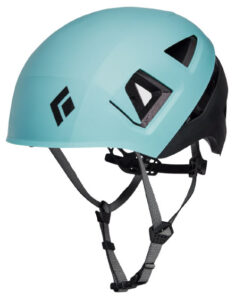
Weight: 10.4 oz. (Evening)
Construction: EPP and EPS with ABS shell.
What we like: Affordable and durable, with a premium look.
What we’re missing: $10 more than the previous Petzl Boreo; It’s hard to stay in shape.
New last year, the Captain fits into the Black Diamond line right between the Vision at the top and the Half Dome at the bottom. This helmet prides itself on its durability, with a hard shell made of durable ABS and flexible EPS foam, and provides ample protection to the sides and back of the head. But it’s not just a rotating lid; The Capitan also features an attractive dual shell design which gives the helmet a premium and less expensive design. Ultimately, this is a great option for the climber who values maximum protection and long-lasting coverage, but is willing to spend up to $10 for the Half Dome for added durability and style.
Like the Petzl Boreo above, the Capitan isn’t very light, so we don’t necessarily recommend it for mountain activities where weight is an issue or for acute red spot burns. But for big wall climbs (like Yosemite’s Captain’s Name) or winter climbs where you expect a lot of ice on your head, this is a tough workhorse that wouldn’t be out of place among high-end models. The main disappointment is the riding position: Black Diamond hasn’t improved the suspension in its latest updates (including the previous Vapor), and the Capitan is another casualty. But if the BD Ultra-Durable Beanie fits your head well, it has many benefits. Finally, it’s also available in a MIPS version for $120, one of the cheapest MIPS climbing helmets on the market.
7. Salah Edelred
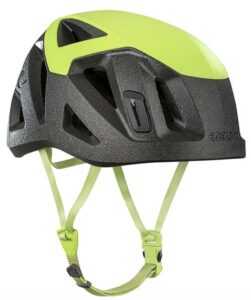
Weight: 7.4 oz.
Construction: EPP with ABS shell.
What we like: Lightweight, well-made helmet.
What we don’t: Heavier and more expensive than the previous concept.
The Edelrid Salathe isn’t the lightest or most durable helmet on this list, but it may offer the best combination of the two. For just 7.4 ounces, you get the same EPP foam we see in many of our flagship models (known for its ability to bounce back rather than shatter on impact), plus a durable ABS plastic shell on top. In other words, the Salathe takes the excellent Petzl Sirocco design and replaces the polycarbonate crown with a solid case, which adds a few grams of weight but guarantees greater durability.
Adding an EPP shell to a helmet is more aesthetically pleasing than anything else, as it allows the helmet to be shaped like a dome rather than a cone (just look at photos of the first generation Sirocco to see this). In other words, the Salathe’s ABS body offers no more protection than the Sirocco’s polycarbonate top, even though it offers better protection against dents and scratches; You just have to decide if they’re worth 1.8 ounces. Weight penalty. The Edelrid’s weight is on par with the 7.5-ounce Vision, which is more affordable at $100 and has an easy-to-use adjustment system. But there’s a lot to like about the Salathe, and while it doesn’t have an official CE certificate for ski touring, it’s designed to be worn with glasses.
8. Half-dome black diamond
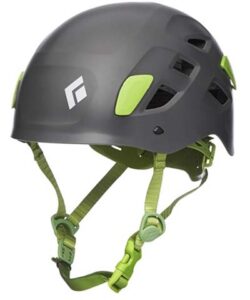
Weight: 11.6 oz. (small/medium size)
Construction: EPS with ABS shell.
What we like: Affordable, reliable and well-designed.
What we don’t like: Heavier and less durable than the previous Petzl Borio.
With the influx of new climbers into the sport, we would be remiss if we didn’t pay homage to Black Diamond’s proven Half Dome. This helmet is not innovative and is not the lightest or most comfortable helmet on the market. But they are affordable, reliable, and most importantly, they will protect your head from falling rocks. Additionally, the updated back dial offers an incredibly comfortable fit, better than previous Boreo models, and Black Diamond also offers a women’s version with increased ventilation and a ponytail-friendly design.
It’s all about protection and durability here: the Half Dome’s heavy ABS shell can absorb significant impacts on its own without damaging the soft polystyrene foam inside, unlike helmets with lighter, less durable polycarbonate shells ( like the Petzl Meteor above). But at the same price, the Petzl Boreo adds EPP foam for added durability, and BD’s Capitan ($70) has a similar design with a more premium aesthetic. But as an affordable, high-quality helmet, the Half Dome remains the best choice for climbers looking to get outdoors without spending a lot of money.
9. “Mammut” wall bridge
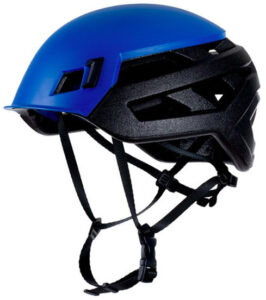
Weight: 6.9 oz. (small/medium size)
Construction: EPP with polycarbonate shell.
What we like: Lightweight, durable and stylish design.
What we don’t: More expensive than the previous BD concept; Adjusting the straps is not very intuitive.
The Mammut Wall Rider is one of the most premium helmets in the game, combining minimal weight, excellent coverage, durable construction and materials. Like previous Sirocco and Vision models, it uses EPP foam wrapped in a lightweight polycarbonate shell, resulting in a full coverage helmet with excellent all-round impact protection. Additionally, the Mammut has a good finish (we especially like the rough one) and has a long history of success in both climbing and rock climbing.
Wall Rider held the top spot for several years, but could no longer compete with more affordable competitors. The Mammut costs $20 more than the Vision, and we found simple strap adjustments to be more difficult to use (the Vision has a more intuitive plastic slider). On the other hand, we like the look of the Wall Rider, which is half a gram lighter than the comparable BD. If you’re willing to spend a little more, this is definitely a great all-around option. Like the Vision, the Wall Rider is also available in a MIPS version, priced at $170.
10. Camp Storm

Weight: 8.1 oz. (Size 1)
Construction: EPS with polycarbonate shell.
What we like: Fits well and is easy to adjust.
What we don’t like: Heavier and less versatile than others in its price range.
Camp has produced a variety of practical and durable helmets over the years, but until recently their designs hadn’t gained much recognition. The Storm is a good start: it comes in four colors and features an internal adjustment system that keeps it comfortable and close to the head. He also took some tips from Camp’s Speed Comp below, resulting in a comfortable, lightweight and well-ventilated mountaineering helmet designed for almost any type of mountain adventure.
The Camp Storm configuration is similar to most helmets on our list, combining EPS foam with a polycarbonate shell. This is the same weight as similar offerings from Petzl and Black Diamond mentioned above. But without the snowboard functionality of the Meteor or the EPP foam of the Vision, it can’t compete. However, the Storm fits a wide range of head sizes and shapes and has a well-thought-out fit system. We know it’s hard to choose between all these options, but if you’re having trouble finding a helmet that’s right for you, the Storm is a good choice.
11. Mammoth Skywalker 3
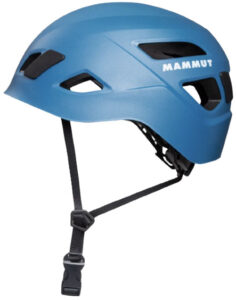
Weight: 11.6 ounces.
Construction: EPP and EPS with ABS shell
What we like: Affordable and well-made, featuring durable EPP foam.
What we don’t like: It falls short in terms of fit, ventilation and weight.
The Skywalker is Mammut’s entry-level offering and is a modern blend of polyethylene and expanded polystyrene with an ABS hard shell. Like the Petzl Boreo above, this is a durable and rugged helmet for beginners and casual climbers, as well as those who want to get the most out of their gear. It’s not particularly light or flashy, but the Skywalker 3 gets the job done and offers nice extras like easily adjustable suspension, soft foam padding, and large vents.
However, The Rise of Skywalker 3 isn’t our first (or even third) budget recommendation. The main reason is that it only comes in one size, which in itself is a problem. In fact, we immediately recommend the less durable Half Dome (which uses polystyrene foam) due to its better fit and finish for both male and female climbers. Additionally, the Skywalker weighs 11.6 ounces, which is heavier than competing helmets, which can add up for a day on the rocks. But for those who like the idea of durable EPP foam and don’t like the more expensive Boreo or the $10 BD Capitan, the Mammut is a worthwhile alternative.
12. Edelrid Shield II
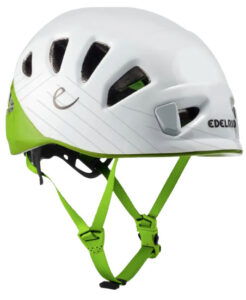
Weight: 8.7 oz. (Size 1)
Construction: EPS with polycarbonate shell.
What we like: Stylish headset for just $100.
What it doesn’t: Heavier than most lightweight competitors.
If you follow the three most important rules of climbing: look good, climb hard, and stay safe (in that order), the Shield II is a worthy choice. The helmet attracts attention thanks to its colorful design and visually appealing shape. But more importantly, you get great coverage and a customizable fit system. If you’re having trouble finding a helmet that fits your unusual head size, the Shield II is a great option.
Despite the EPS and polycarbonate body, the Shield II weighs 8.7 ounces, making it the heaviest of our lightweight options. We also noticed that the adjustment dial doesn’t fold as neatly into the helmet shell as on most other models, making the Shield II a huge addition to your pack. But with 10 large slots, a slightly lower price than most, and a sleek design, the Shield II is still worth a look.
13. Grivel Stealth
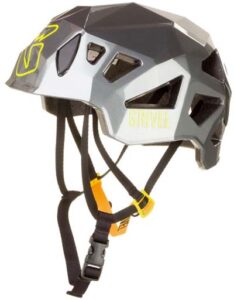
Weight: 6.7 oz.
Construction: EPS with polycarbonate shell.
What we like: Best weight, price and coverage.
What we don’t like: Available in one size; Looks like it’s from the space age.
The Grivel Stealth offers an impressive price-to-weight ratio, excellent coverage, and a durable construction that you can love or hate. This is an all-round reliable option. The main feature is the unique flat panel design which sits low on the head and is unlikely to move in the event of a rockfall or collision. According to Greville, this design provides a stronger barrier and better impact protection than a traditional canopy helmet. The design is completed with a simple adjustment strap that, unlike the Sirocco or Wall Rider, is surprisingly easy to loosen and tighten even with gloves on.
As for the negatives, let’s start by saying that we’re not big fans of the Stealth’s celestial feel, but we know that design is largely subjective. In terms of fit, the Grivel is only available in one size and the chin strap is fixed and can penetrate the neck. However, some climbers will really appreciate the low profile design, and it doesn’t hurt that the Stealth is incredibly light at just 6.7 ounces. Grivel now also produces the Duetto, an EPP design that joins the Camp Speed Comp below as one of the few mountaineering helmets also certified for alpine skiing.
14. Camp Speed

Weight: 12.7 oz.
Construction: EPS with polycarbonate shell.
What we like: The most versatile alpine game.
What we don’t like: Heavy if you’re looking for a high-performance helmet specifically for climbing.
The Camp Speed Comp is unique: it is not only a climbing helmet, but also functions as an alpine ski helmet and a racing ski helmet. But don’t confuse the Petzl Meteor and Sirocco certifications with ski touring: Speed Comp takes it to the next level with a durable design that offers more protection and meets the EN 1077 standard for most ski helmets. . Additionally, its relatively thick outer shell is slightly more durable than many of the EPS versions mentioned above. Some climbers find the shape of the Speed Comp a little rounder than they are used to, so if Black Diamond or Petzl helmets don’t fit your head well, this may be the solution for YOU.
However, while it may be light on the slopes, the Speed Comp is a little heavy for a molded climbing helmet. Overall, we only recommend the Speed Comp if you spend a lot of time alternating between climbing and skiing and are looking for a helmet that does both. If you’re not an avid skier and are just looking for a ski touring helmet, the Petzl Meteor above is much lighter, costs $40 less, and even lets you wear goggles.
Tips for buying climbing helmets
- Foam types: EPP or EPS.
- Housing types: ABS or polycarbonate.
- When to use a mountaineering helmet?
- Protection: Foam, lining and MIPS types.
- comfort
- Size and adaptability
- Climbing helmets for women
- Breath
- Weight
- sustainability
- Compatibility with headlights
- Put on your ski helmet
Foam types: EPP or EPS
We briefly touched on expanded polystyrene and expanded polystyrene in the product descriptions above, but it’s worth going into more detail about the differences between these two materials. After all, this barrier will protect the most important part of your body.
Expanded Polystyrene (EPS)
Expanded polystyrene (EPS) has long been the shock-absorbing foam of choice for mountaineering helmets. It’s very difficult and it’s very helpful to absorb a big shock in one go. Expanded polystyrene is known to break upon impact. In fact, in some of the lighter EPS models, like the Petzl Meteor and Edelrid Shield II, the EPS foam is so delicate that it can break simply by dropping it on the ground or placing it under heavy backpack gear. Once the polystyrene foam begins to show these creases and cracks, its integrity is compromised. If you notice cracks inside your helmet, it’s time to replace it.

Foam types: EPP or EPS.
We briefly touched on expanded polystyrene and expanded polystyrene in the product descriptions above, but it’s worth going into more detail about the differences between these two materials. After all, this barrier will protect the most important part of your body.
Expanded Polystyrene (EPS)
Expanded polystyrene (EPS) has long been the shock-absorbing foam of choice for mountaineering helmets. It’s very difficult and it’s very helpful to absorb a big shock in one go. Expanded polystyrene is known to break upon impact. In fact, in some of the lighter EPS models, like the Petzl Meteor and Edelrid Shield II, the EPS foam is so delicate that it can break simply by dropping it on the ground or placing it under heavy backpack gear. Once the polystyrene foam begins to show these creases and cracks, its integrity is compromised. If you notice cracks inside your helmet, it’s time to replace it.
Shell types: ABS or polycarbonate.
Now that we’ve looked at the inside of the material, let’s see what protects it. We talked about some “hard helmets” with ABS shells, such as the Black Diamond Half Dome and the Black Diamond Capitan. ABS plastic cases can absorb significant shock, provide good protection from debris falling from above, and are generally less expensive than other options. However, they tend to be thicker and more durable than polycarbonate helmets, and with them comes additional weight (which is why we recommend them primarily for steep riding rather than trail riding).
However, for long days on the wall, choosing a helmet with a polycarbonate shell (or crown, like the Petzl Sirocco or the Black Diamond Vapor) to save weight certainly helps. However, lighter helmets should always be handled with greater care as they are damaged more easily. For beginners or climbers on a budget who want more durability for their investment, a hard shell helmet is the way to go.

When to use a climbing helmet?
It is generally accepted that helmets are mandatory equipment for all climbing. The mountains are unstable and there are objective dangers. However, we believe that no matter where you climb (in the mountains, on a rock, or even in the gym), gravity is (literally) a force to be reckoned with. Even in popular, established areas, rocks can fall, people can drop objects, and perpetrators can cause head injuries. A helmet is always necessary for your safety. Now that that’s all over, here are our tips for every type of climbing.
Mountain climbing
It goes without saying: almost no one goes into the mountains without a helmet. Rocks are loose, waterfalls are often muddy, and even snow and ice succumb to gravity. Since the approach to the mountain can be long and you will likely spend the entire day carrying or carrying your helmet, you will need a lightweight bucket with a suspension system that can be folded into it. Durability is also an important factor – there’s nothing more frustrating than a misfire after being out of your car for a few days. Our top picks for mountain riding are lightweight, durable polypropylene foam helmets like the Petzl Sirocco and Black Diamond Vapor. If you go out often, it’s worth it.
Long distance climbing
For long days on the wall (think Chief in Squamish or Black Velvet Canyon in Red Rock), you’ll want a lightweight helmet with good fit, ventilation and comfort. EPP foam helmets like the ones mentioned above are also our top recommendations for multi-level climbing, but those on a budget can definitely get away with a slightly heavier and less durable design. Look for a helmet that weighs less than 10 ounces, has a one-handed adjustment system (which you won’t find on ultralight models, but it’s a great feature), and a headlight mount. For long, multilevel climbs, our top picks are helmets like the Black Diamond Vision, Petzl Meteor, and Edelrid Shield II. You can get by with a helmet with a heavier ABS shell, but your neck may feel it at the end of the day.
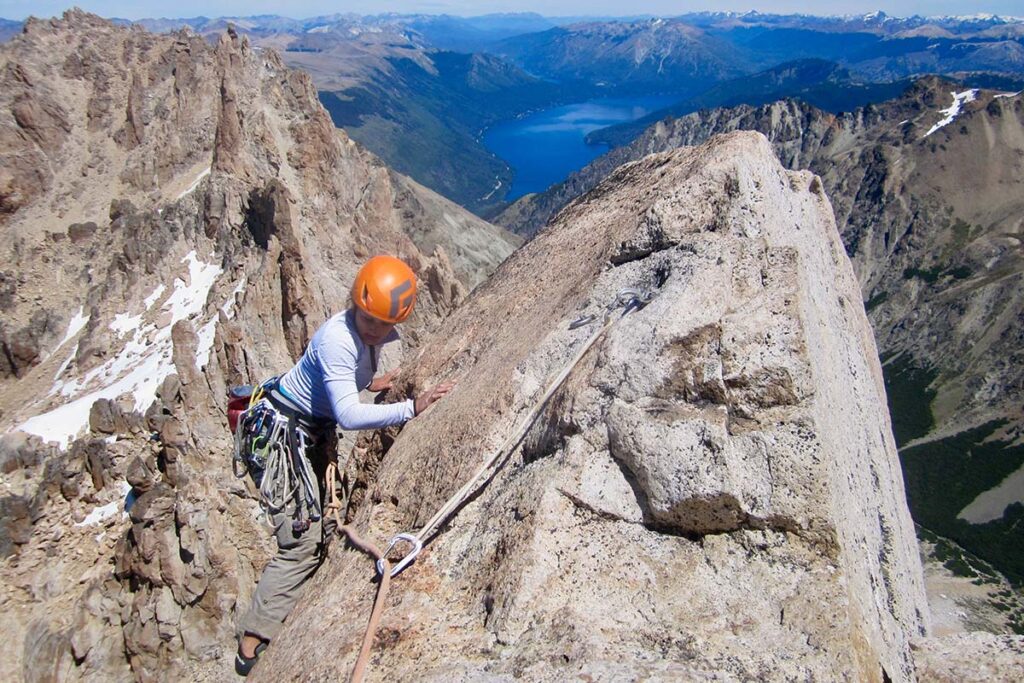
Squabbling
We know many people who leave their helmet at home on the rock for a few days (when climbing a single route), but this logic is deeply flawed. You’re more likely to get off the ground, which means you’re more likely to fall off a cliff. Even if you know exactly where the rope is, you can still land with one foot behind the rope. When this happens, there’s a good chance you’ll turn around and bang your head against the wall. This doesn’t just happen to beginners who are unfamiliar with proper chain management. A few years ago, a famous climber fell without a helmet on Smith Rock, a rock known for its poor rock and lack of head protection, and many locals have since changed their behavior.
Ok, enough time on our platform. Ultimately the decision is yours, and if you decide to wear your helmet on a rock, you will have to make a decision. Are you taking it to the next level? In this case you may need a light helmet, a light harness and a rope. Consider EPP or EPS foam with a polycarbonate top, like the helmets mentioned in the previous sections. But since you’ll likely have to take off your helmet when you’re not climbing, most climbers can get away with wearing a helmet that emphasizes durability and low price over weight savings. Look for a stiff ABS body, an easy adjustment system, and a price under $70. The Black Diamond Capitan, Half Dome, and Petzl Boreo/Borea are some of our favorites to climb.
Protection: Foam, lining and MIPS types.
For starters, all climbing helmets are guaranteed to meet international standards (UIAA 106 and EN 12492, if you’re wondering), meaning they all meet certain safety requirements. However, there are some differences in the level of impact protection offered by each model. The first factor is the type of foam, which we talked about in detail earlier. In short: EPP foam absorbs shock, but EPS foam breaks down. Therefore, when dealing with styrofoam, a broken helmet is considered a no-no. On the other hand, PPE caps can be licked even if they are still marked, meaning that PPE is the most protective option of all.
The second important factor is knowing which parts of the head are protected by the helmet. Thanks to the UIAA and EN, all helmets are designed to withstand impacts from above, which typically come in the form of falling rocks. However, only a few provide adequate protection on the front, back and sides. This comprehensive coverage is especially important if you are an avid climber, as it is not uncommon to fall. There are rumors that there is a proposed UIAA standard for head protection, but we are currently looking for companies to mention this in their product specifications. For example, Black Diamond Vision offers improved fall protection and some Petzl models are certified to “top and side protection” standards (e.g. Sirocco, Boreo/Borea, Meteor).
Finally, MIPS has finally entered the world of climbing with Black Diamond Vision, Capitan and Mammut Wall Rider, among others. MIPS (which stands for Multi-Directional Impact Protection System) is widely used in ski and bicycle helmets and provides additional protection by creating a low-friction layer between the helmet shell and the padding. The goal is that, when hit at an angle, the MIPS layer will allow the bullet to move enough to reduce rotational forces acting on the head and brain. In other words, the MIPS pad absorbs some of the impact. You’ll pay $40 to $60 more (Black Diamond Vision MIPS costs $150 versus $100 for the standard version), but for some, it’s worth it.

comfort
In addition to safety, one of the most important features of a climbing helmet is comfort. If it’s not comfortable, you won’t wear it. If you don’t use it, it won’t protect you. Comfort is subjective and largely depends on the shape of your head. For example, the biggest criticism we heard about the Petzl Sirocco was that it wasn’t suitable for larger heads. As with most climbing gear, the best thing you can do with helmets is to try them on before you buy. That said, we didn’t notice much difference in comfort between different companies, but we definitely saw it between models. In almost all cases, heavier means less comfortable and lighter means better.
Size and adaptability
A good mountaineering helmet should be comfortable, but not move too much when you move your head. During excursions we always ask our young customers if they like ice cream, to which they expressly nod. If the helmet fits properly, they won’t move as they express their love for cold treats. If it bobs up and down or stops showing the front, adjust the size of the back and chin strap. And if the helmet fits your head more like a ski mask than a baseball cap, then it’s too small.
Most mountaineering helmet models are available in two sizes and usually one size overlaps the other. If you’re near the tipping point, we suggest trying the headset before you buy (though that’s not a bad idea either way). As for adjustments, all mountaineering helmets have two straps: one around the head and one around the chin. Some helmets, like the Sirocco (usually weight-oriented), have a strap and buckle to adjust the headband. Others, like the Black Diamond Capitan, offer a two-way plastic ratchet system that requires two-handed adjustment. The Black Diamond Half Dome offers a simple one-handed adjustment system with a round knob that tightens when turned in one direction and loosens in the other.
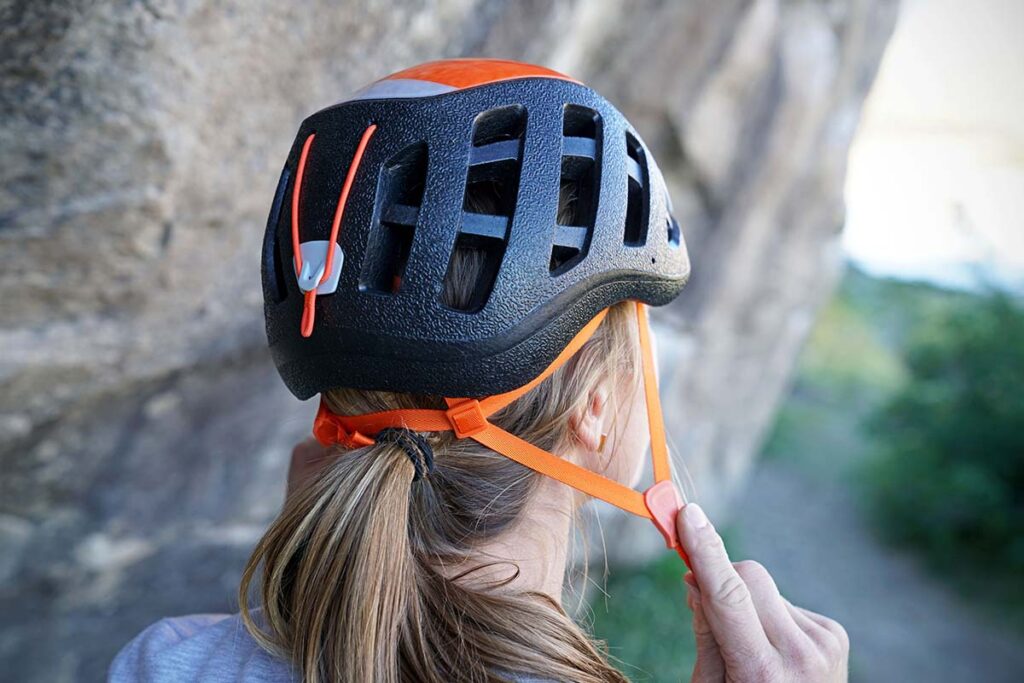
Climbing helmets for women
Some of the helmets on our list have women’s models, including the Black Diamond Half Dome, Petzl Borea, and Petzl Meteora. These women’s versions have one key feature: a frame and suspension that houses a ponytail, which is an upward curve at the back of the head. In most cases (and this is the woman who does the ponytail) this doesn’t seem like a particularly necessary feature, although some women will like the idea. But in general, mountaineering helmets are unisex clothing and fit all head types, sizes and hairstyles.
Breath
In the past, one of the biggest complaints about mountaineering helmets was that they didn’t breathe well enough, leaving your head sweaty, hot and uncomfortable. As technology continues to improve, we see helmet manufacturers adding more and more ventilation. While we’re excited about this trend, it’s worth noting the inherent drawbacks of improved ventilation. More holes mean more empty space and less material to protect the head. It is possible, although unlikely, that a thin stone or piece of ice slipped through it. And if you’re primarily a winter or cold-weather climber, ventilation may be more of a hindrance than an advantage. Overall, we think helmets like the Sirocco and Petzl Meteor represent a good compromise between protection and ventilation.
Weight
The headphones on this list range from 5.6 ounces on the low end to 12.7 ounces on the high end, and there are heavier models that don’t make a difference. While 13 ounces (less than 1 pound) seems like a small amount to complain about, it’s still more than double the weight of the lightest helmet available. The truth is, those grams can add up quickly. In any big pitch climbing scenario, or even long days of climbing, the helmet is put on in the morning and left on for the rest of the day. Personally, we prefer our helmets to be as soft as possible. Plus, lighter earbuds place less weight on your neck and don’t move around your head as much when you look up and down.
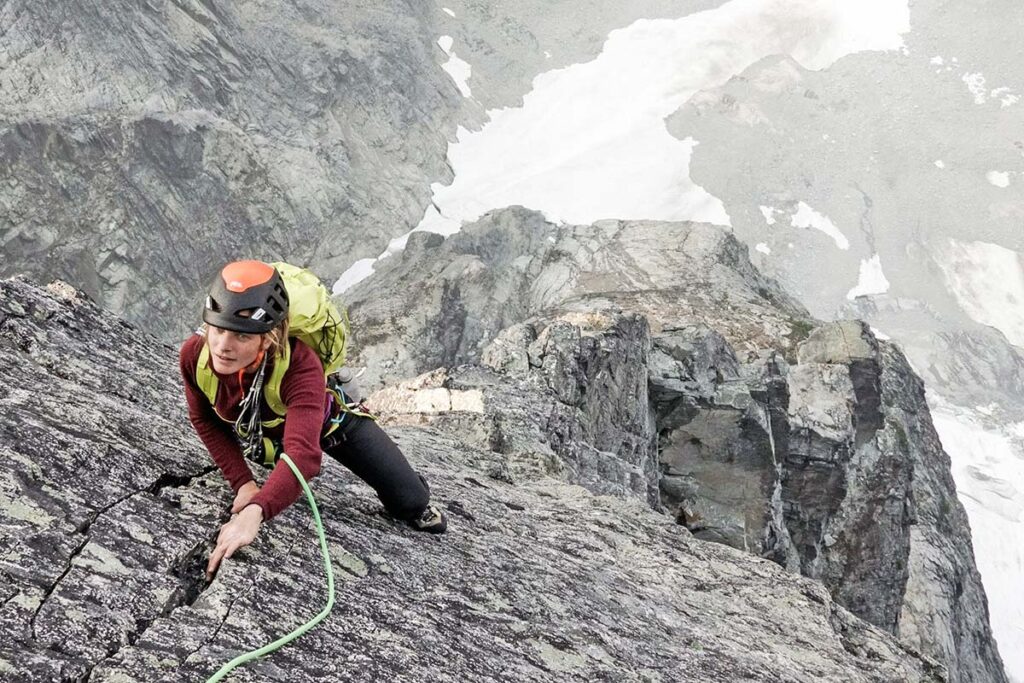
sustainability
Typically, weight and durability are inversely proportional to climbing gear (or any type of outdoor gear). In other words, the lighter the equipment, the less durable it is. However, in the world of mountaineering helmets, this pattern is not always true. EPP foam helmets like the Petzl Sirocco and Mammut Wall Rider are some of the lightest and most durable helmets on the market. Remember that EPP foam is designed to flex and absorb shock, while EPS foam breaks down to resist blunt forces. Among the expanded polystyrene models, those with rigid ABS plastic shells resist corrosion much better than those with polycarbonate shells.
Once you have chosen a helmet, it is important to know how to measure its wear. Generally, a fall or impact is enough to end the life of an EPS helmet; Any cracks in the foam mean that the integrity of the helmet has been compromised. But the most difficult thing is that not all the creases are visible (some are located inside, under the polycarbonate or ABS shell). To check, look for large scratches on the frame: a sign of internal damage. It is also important to check the straps, the suspension system, the buckle and, in the case of ABS helmets, the resistance of the foam that adheres to the shell. On the other hand, because EPP does not degrade like EPS, these models are not subject to the “replace your helmet after a crash” rule. However, you will need to continue testing the foam. Because of the way they are partially open on helmets like the Sirocco and Wall Rider, this should be a fairly simple process.

Compatibility with headlights
You’ll be hard-pressed to find a climbing helmet that doesn’t claim to be compatible with headlamps, so it’s pretty much a no-brainer. However, some helmets hold the flashlight better than others. For example, the ergonomic back strap of the Petzl Sirroco and Black Diamond Capitan is very simple, but the attachment points of the Grivel Stealth are very difficult to use. Some clamps can also be removed to save weight, but moving these parts in and out of the foam can cause the attachment points to loosen and loosen over time. The bottom line is that any helmet you buy will be headlight compatible, you just need to research the system you are using.

